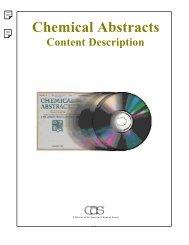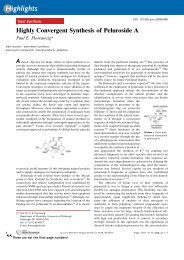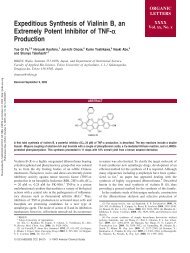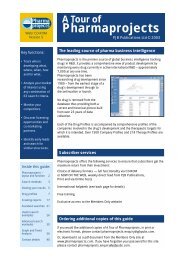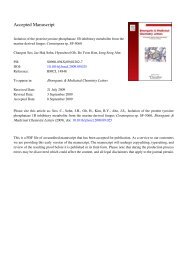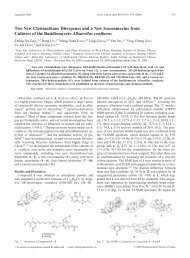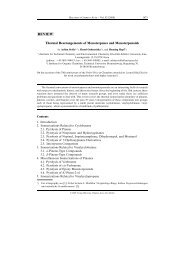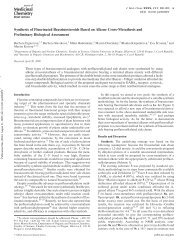Total Synthesis and Structure−Activity Investigation of the Marine ...
Total Synthesis and Structure−Activity Investigation of the Marine ...
Total Synthesis and Structure−Activity Investigation of the Marine ...
You also want an ePaper? Increase the reach of your titles
YUMPU automatically turns print PDFs into web optimized ePapers that Google loves.
Downloaded by SHANGHAI INST OF ORG CHEM on August 21, 2009<br />
Published on August 6, 2009 on http://pubs.acs.org | doi: 10.1021/ja904604x<br />
Introduction<br />
<strong>Total</strong> <strong>Syn<strong>the</strong>sis</strong> <strong>and</strong> Structure-Activity <strong>Investigation</strong> <strong>of</strong> <strong>the</strong><br />
<strong>Marine</strong> Natural Product Neopeltolide<br />
Daniel W. Custar, † Thomas P. Zabawa, † John Hines, ‡ Craig M. Crews, ‡ <strong>and</strong><br />
Karl A. Scheidt* ,†<br />
Department <strong>of</strong> Chemistry, Center for Molecular InnoVation <strong>and</strong> Drug DiscoVery, Northwestern<br />
UniVersity, EVanston, Illinois, 60208, <strong>and</strong> Department <strong>of</strong> Molecular, Cellular, <strong>and</strong><br />
DeVelopmental Biology, Department <strong>of</strong> Chemistry, <strong>and</strong> Department <strong>of</strong> Pharmacology, Yale<br />
UniVersity, New HaVen, Connecticut 06520<br />
Received June 11, 2009; E-mail: scheidt@northwestern.edu<br />
Abstract: The total syn<strong>the</strong>sis <strong>and</strong> biological evaluation <strong>of</strong> neopeltolide <strong>and</strong> analogs are reported. The key<br />
bond-forming step utilizes a Lewis acid-catalyzed intramolecular macrocyclization that installs <strong>the</strong><br />
tetrahydropyran ring <strong>and</strong> macrocycle simultaneously. Independent <strong>of</strong> each o<strong>the</strong>r, nei<strong>the</strong>r <strong>the</strong> macrolide<br />
nor <strong>the</strong> oxazole side chain substituents <strong>of</strong> neopeltolide can inhibit <strong>the</strong> growth <strong>of</strong> cancer cell lines. The<br />
biological data <strong>of</strong> <strong>the</strong> analogs indicate that alterations to ei<strong>the</strong>r <strong>the</strong> ester side chain or <strong>the</strong> stereochemistry<br />
<strong>of</strong> <strong>the</strong> macrolide result in a loss <strong>of</strong> biological activity.<br />
Background. Natural products continue to be excellent<br />
sources for new drug c<strong>and</strong>idates, especially in <strong>the</strong> area <strong>of</strong><br />
anticancer <strong>the</strong>rapeutics. 1-3 In many instances, <strong>the</strong> limited<br />
amount <strong>of</strong> natural material that is typically isolated severely<br />
limits <strong>the</strong> ability <strong>of</strong> <strong>the</strong> cancer research community to investigate<br />
important lead compounds. Organic syn<strong>the</strong>sis can facilitate <strong>the</strong><br />
preparation <strong>of</strong> sufficient quantities <strong>of</strong> target compounds when<br />
natural sources are scarce or no longer available. Additionally,<br />
syn<strong>the</strong>tic routes to molecules can be manipulated to create<br />
simplified analogs <strong>of</strong> <strong>the</strong> target compound that may have <strong>the</strong><br />
same or enhanced biological activity. <strong>Total</strong> syn<strong>the</strong>sis can also<br />
confirm <strong>the</strong> structural assignment <strong>and</strong> absolute stereochemistry<br />
<strong>of</strong> a natural product, which was required for neopeltolide 1. 4<br />
In 2007, Wright <strong>and</strong> co-workers reported <strong>the</strong> structure <strong>of</strong> a<br />
new, highly cytotoxic, natural product neopeltolide 2, which<br />
was isolated from sponges most closely related to <strong>the</strong> genus<br />
Daedalopelta Sollas. 5 The key structural features <strong>of</strong> neopeltolide<br />
include a trisubstituted 2,6-cis-tetrahydropyran moiety, which<br />
is embedded in a 14-membered macrolactone containing six<br />
stereogenic centers. The pyran subunit possesses a highly<br />
functionalized oxazole substituent that is identical to <strong>the</strong> side<br />
chain <strong>of</strong> leucasc<strong>and</strong>rolide A. The molecular formula <strong>and</strong> tricyclic<br />
nature <strong>of</strong> <strong>the</strong> molecule were determined by high resolution mass<br />
spectrometry (HRMS) <strong>and</strong> 13 C NMR spectroscopy. The planar<br />
† Northwestern University.<br />
‡ Yale University.<br />
(1) Newman, D. J.; Cragg, G. M. J. Nat. Prod. 2004, 67, 1216–1238.<br />
(2) Newman, D. J.; Cragg, G. M. Curr. Med. Chem. 2004, 11, 1693–<br />
1713.<br />
(3) Newman, D. J.; Cragg, G. M.; Snader, K. M. J. Nat. Prod. 2003, 66,<br />
1022–1037.<br />
(4) Custar, D. W.; Zabawa, T. P.; Scheidt, K. A. J. Am. Chem. Soc. 2008,<br />
130, 804–805.<br />
(5) Wright, A. E.; Botelho, J. C.; Guzman, E.; Harmody, D.; Linley, P.;<br />
McCarthy, P. J.; Pitts, T. P.; Pomponi, S. A.; Reed, J. K. J. Nat. Prod.<br />
2007, 70, 412–416.<br />
Figure 1. Neopeltolide structures.<br />
structure was elucidated by <strong>the</strong> analysis <strong>of</strong> one (1D)- <strong>and</strong> twodimensional<br />
(2D) 1 H NMR spectroscopy, including advanced<br />
TOCSY <strong>and</strong> COSY experimentation. The relative stereochemistry<br />
<strong>of</strong> neopeltolide was originally proposed based on 1D <strong>and</strong><br />
2D NOESY spectra, which ultimately lead to <strong>the</strong> incorrect<br />
structural assignment. The key protons on <strong>the</strong> macrolide (H-3,<br />
H-7, H-9, H-11, <strong>and</strong> H-13) were assigned to all be syn in<br />
relationship with each o<strong>the</strong>r, all adopting a pseudoaxial orientation<br />
(Figure 1). The absolute stereochemistry <strong>of</strong> <strong>the</strong> molecule<br />
could not be initially established due to <strong>the</strong> lack <strong>of</strong> available<br />
material.<br />
Neopeltolide potently inhibits proliferation <strong>of</strong> a number <strong>of</strong><br />
cancer cell lines. Although it exhibits IC50 values in <strong>the</strong> low<br />
nanomolar to subnanomolar range, <strong>the</strong> efficacy with which<br />
10.1021/ja904604x CCC: $40.75 © XXXX American Chemical Society J. AM. CHEM. SOC. XXXX, xxx, 000 9 A
Downloaded by SHANGHAI INST OF ORG CHEM on August 21, 2009<br />
Published on August 6, 2009 on http://pubs.acs.org | doi: 10.1021/ja904604x<br />
ARTICLES Custar et al.<br />
Scheme 1. Syn<strong>the</strong>tic Plan<br />
neopeltolide inhibits cancer cell growth varies, with some cell<br />
lines completely inhibited <strong>and</strong> o<strong>the</strong>rs only partially inhibited. 5,6<br />
Based on that limited efficacy <strong>and</strong> data showing an accumulation<br />
<strong>of</strong> cells in <strong>the</strong> G1 phase, Wright hypo<strong>the</strong>sized that neopeltolide<br />
may be at least partially cytostatic to <strong>the</strong>se cell lines ra<strong>the</strong>r than<br />
simply cytotoxic. Additionally, neopeltolide is also a potent<br />
inhibitor <strong>of</strong> <strong>the</strong> fungal pathogen C<strong>and</strong>ida albicans (MIC value<br />
<strong>of</strong> 0.625 µg/mL), which severely <strong>and</strong> adversely affects <strong>the</strong> health<br />
<strong>of</strong> AIDS patients, potentially resulting in death. Preliminary<br />
investigations into <strong>the</strong> mechanism <strong>of</strong> action suggest that it does<br />
not interact with ei<strong>the</strong>r tubulin or actin. Recently, Kozmin, Kron<br />
<strong>and</strong> co-workers have advanced that <strong>the</strong> cellular target <strong>of</strong><br />
neopeltolide is <strong>the</strong> cytochrome bc1 complex <strong>and</strong> that <strong>the</strong><br />
molecule inhibits mitochondrial ATP syn<strong>the</strong>sis. However, <strong>the</strong>ir<br />
investigations seemingly employed racemic material <strong>and</strong> it is<br />
unclear if <strong>and</strong> how this aspect impacts <strong>the</strong>ir biological studies. 6<br />
The macrolide ring <strong>of</strong> neopeltolide has similarities to <strong>the</strong><br />
macrocycles found in <strong>the</strong> callipeltosides, 7 lyngbyaloside, 8,9<br />
lyngbouilloside, 10 <strong>and</strong> <strong>the</strong> aurisides. 11 The key distinction<br />
between <strong>the</strong>se natural products is <strong>the</strong> C-7 hemiketal functionality<br />
as opposed to <strong>the</strong> reduced e<strong>the</strong>r <strong>of</strong> <strong>the</strong> tetrahydropyran ring<br />
system present in neopeltolide. Additionally, several <strong>of</strong> <strong>the</strong>se<br />
molecules exhibit modest to slight cytotoxicity as opposed to<br />
<strong>the</strong> high biological activity <strong>of</strong> neopeltolide. Leucasc<strong>and</strong>rolide<br />
A is also structurally similar <strong>and</strong> has comparable activity to<br />
neopeltolide. 12 Preliminary biological studies <strong>of</strong> leucasc<strong>and</strong>rolide<br />
A have shown that: (i) <strong>the</strong> macrolide core is essential for tumor<br />
cytotoxicity, <strong>and</strong> (ii) <strong>the</strong> oxazole side chain is important for<br />
fungistatic activity. Due to <strong>the</strong> interesting structural aspects, as<br />
well as <strong>the</strong> high biological activity, neopeltolide has garnered<br />
(6) Ulanovskaya, O. A.; Janjic, J.; Suzuki, M.; Sabharwal, S. S.;<br />
Schumacker, P. T.; Kron, S. J.; Kozmin, S. A. Nat. Chem. Biol. 2008,<br />
4, 418–424.<br />
(7) Zampella, A.; DAuria, M. V.; Minale, L.; Debitus, C.; Roussakis, C.<br />
J. Am. Chem. Soc. 1996, 118, 11085–11088.<br />
(8) Luesch, H.; Yoshida, W. Y.; Harrigan, G. G.; Doom, J. P.; Moore,<br />
R. E.; Paul, V. J. J. Nat. Prod. 2002, 65, 1945–1948.<br />
(9) Klein, D.; Braekman, J. C.; Daloze, D.; H<strong>of</strong>fmann, L.; Demoulin, V.<br />
J. Nat. Prod. 1997, 60, 1057–1059.<br />
(10) Tan, L. T.; Marquez, B. L.; Gerwick, W. H. J. Nat. Prod. 2002, 65,<br />
925–928.<br />
(11) Sone, H.; Kigoshi, H.; Yamada, K. J. Org. Chem. 1996, 61, 8956–<br />
8960.<br />
(12) DAmbrosio, M.; Guerriero, A.; Debitus, C.; Pietra, F. HelV. Chim.<br />
Acta 1996, 79, 51–60.<br />
B J. AM. CHEM. SOC. 9 VOL. xxx, NO. xx, XXXX<br />
Scheme 2. Sc<strong>and</strong>ium(III) Triflate Methodology<br />
<strong>the</strong> attention <strong>of</strong> <strong>the</strong> syn<strong>the</strong>tic community <strong>and</strong> has resulted in<br />
several o<strong>the</strong>r total syn<strong>the</strong>ses. 6,13-19<br />
<strong>Syn<strong>the</strong>sis</strong> Plan. An important goal <strong>of</strong> our syn<strong>the</strong>sis was to<br />
develop a highly convergent <strong>and</strong> flexible syn<strong>the</strong>tic route with<br />
<strong>the</strong> ability to easily prepare analogs. Excision <strong>of</strong> <strong>the</strong> oxazole<br />
side chain affords macrocyclic core 3 (Scheme 1), which<br />
contains an embedded tetrahydropyran that we envisioned<br />
forming through our previously developed Lewis acid-catalyzed<br />
cyclization. 20 This methodology allows for a highly diastereoselective<br />
(>20:1 dr) cyclization <strong>of</strong> -hydroxy dioxinone 9 with<br />
aldehyde 10 in <strong>the</strong> presence <strong>of</strong> a catalytic amount <strong>of</strong> Sc(OTf)3<br />
to furnish bicyclic heterocycle 11 (Scheme 2). Heating 11 in<br />
<strong>the</strong> presence <strong>of</strong> H2O resulted in <strong>the</strong> formation <strong>of</strong> a 2,6-cistetrahydropyranone.<br />
Notably, our studies have indicated that <strong>the</strong><br />
use <strong>of</strong> optically enriched -hydroxy dioxinone 9 in <strong>the</strong> cyclization<br />
results in complete retention <strong>of</strong> optical purity. Utilizing this<br />
methodology, <strong>the</strong> tetrahydropyran core could be constructed as<br />
a single diastereomer in two different manners: (1) through an<br />
(13) Youngsaye, W.; Lowe, J. T.; Pohlki, F.; Ralifo, P.; Panek, J. S. Angew.<br />
Chem., Int. Ed. 2007, 46, 9211–9214.<br />
(14) Fuwa, H.; Naito, S.; Goto, T.; Sasaki, M. Angew. Chem., Int. Ed. 2008,<br />
47, 4737–4739.<br />
(15) Paterson, I.; Miller, N. A. Chem. Commun. 2008, 4708–4710.<br />
(16) Kartika, R. G., T. R.; Taylor, R. E. Org. Lett. 2008, 10, 5047–5050.<br />
(17) Woo, S. K.; Kwon, M. S.; Lee, E. Angew. Chem., Int. Ed. 2008, 47,<br />
3242–3244.<br />
(18) Vintonyak, V. V.; Maier, M. E. Org. Lett. 2008, 10, 1239–1242.<br />
(19) Tu, W.; Floreancig, P. E. Angew. Chem., Int. Ed. 2009, 48, 4567–<br />
4571.<br />
(20) Morris, W. J.; Custar, D. W.; Scheidt, K. A. Org. Lett. 2005, 7, 1113–<br />
1116.
Downloaded by SHANGHAI INST OF ORG CHEM on August 21, 2009<br />
Published on August 6, 2009 on http://pubs.acs.org | doi: 10.1021/ja904604x<br />
<strong>Marine</strong> Natural Product Neopeltolide ARTICLES<br />
Table 1. Optimization <strong>of</strong> Aldol Reaction a<br />
entry solvent R-BINOL (mol %) additive yield (%) b ee (%) c<br />
1 THF 8 4 Å MS 50 73 d,e<br />
2 THF 8 4 Å MS 53 71 d<br />
3 THF 10 4 Å MS 60 78 d,e<br />
4 toluene 10 4 Å MS 30 71<br />
5<br />
6<br />
CH2Cl2<br />
THF<br />
10<br />
10<br />
4ÅMS<br />
3 Å MS<br />
- -<br />
f<br />
65 68<br />
7 THF 10 3 Å MS 66 63<br />
8 THF 10 3 Å MS f,g<br />
65 81<br />
9 THF 10 4 Å MS g<br />
57 74<br />
10 THF 15 4 Å MS g<br />
66 80<br />
11 THF 10 4 Å MS 63 88<br />
12 THF 15 4 Å MS 64 60<br />
a Reactions performed under N2 at 0.17 M (precomplexation<br />
concentration 0.53 M) with Ti(i-OPr)4 <strong>and</strong> lig<strong>and</strong> after 60 min, reaction<br />
cooled to -78 °C followed by addition <strong>of</strong> 13 <strong>and</strong> 14. b Isolated yields<br />
after column chromatography. c Determined by chiral HPLC. d Precomplexation<br />
concentration 0.21 M. e Slowly warmed to 23 °C. f MS pellets<br />
(3 Å). g Dried in a reduced pressure oven at 145 °C for 2 days.<br />
intermolecular cyclization followed by a Yamaguchi macrolactonization<br />
to create <strong>the</strong> macrocycle, 21 or (2) through a new<br />
intramolecular cyclization that would simultaneously form <strong>the</strong><br />
macrocycle. At <strong>the</strong> time <strong>of</strong> our initial publication, we were aware<br />
<strong>of</strong> only a single report in <strong>the</strong> literature in which a Prins<br />
cyclization was employed to provide a pyran-containing macrocycle.<br />
22 Since we reported <strong>the</strong> syn<strong>the</strong>sis <strong>of</strong> neopeltolide several<br />
o<strong>the</strong>r research groups have successfully utilized <strong>the</strong> Prins<br />
cyclization strategy as a key step in <strong>the</strong>ir syn<strong>the</strong>ses. 17,23-26 The<br />
precursors to both cyclization pathways are carboxylic acid 7<br />
<strong>and</strong> alcohol 8.<br />
Results <strong>and</strong> Discussion<br />
Carboxylic Acid Fragment. The syn<strong>the</strong>sis began with monoprotection<br />
<strong>of</strong> 1,3-propanediol as a silyl e<strong>the</strong>r followed by<br />
subsequent oxidation with TPAP 27 to afford aldehyde 13, <strong>the</strong><br />
precursor to <strong>the</strong> vinylogous aldol reaction. Using <strong>the</strong> procedure<br />
as reported by Scettri <strong>and</strong> co-workers, 28,29 <strong>the</strong> aldol reaction<br />
with aldehyde 13 <strong>and</strong> dienoxy silane 14 30,31 resulted in moderate<br />
yields <strong>and</strong> enantioselectivities (Table 1, entries 1 <strong>and</strong> 2). Varying<br />
<strong>the</strong> solvent from THF <strong>and</strong> trying alternative drying agents did<br />
(21) Inanaga, J.; Hirata, K.; Saeki, H.; Katsuki, T.; Yamaguchi, M. Bull.<br />
Chem. Soc. Jpn. 1979, 52, 1989–1993.<br />
(22) Schulteelte, K. H.; Hauser, A.; Ohl<strong>of</strong>f, G. HelV. Chim. Acta 1979, 62,<br />
2673–2680.<br />
(23) Bahnck, K. B.; Rychnovsky, S. D. J. Am. Chem. Soc. 2008, 130,<br />
13177–13181.<br />
(24) Boeckman Jr, R. K.; Potenza, J. C.; Enholm, E. J. J. Org. Chem. 1987,<br />
52, 469–472.<br />
(25) Hoye, T. R.; Danielson, M. E.; May, A. E.; Zhao, H. Angew. Chem.,<br />
Int. Ed. 2008, 47, 9743–9746.<br />
(26) Wender, P. A.; DeChristopher, B. A.; Schrier, A. J. J. Am. Chem.<br />
Soc. 2008, 130, 6658–6659.<br />
(27) Ley, S. V.; Norman, J.; Griffith, W. P.; Marsden, S. P. <strong>Syn<strong>the</strong>sis</strong> 1994,<br />
639–666.<br />
(28) De Rosa, M.; Acocelli, M. R.; Villano, R.; Soriente, A.; Scettri, A.<br />
Tetrahedron Lett. 2003, 44, 6087–6090.<br />
(29) De Rosa, M.; Acocelli, M. R.; Villano, R.; Soriente, A.; Scettri, A.<br />
Tetrahedron: Asymmetry 2003, 14, 2499–2502.<br />
(30) Singer, R. A.; Carreira, E. M. J. Am. Chem. Soc. 1995, 117, 12360–<br />
12361.<br />
(31) Casiraghi, G.; Zanardi, F.; Appendino, G.; Rassu, G. Chem. ReV. 2000,<br />
100, 1929–1972.<br />
Scheme 3. Dioxinone Fragment <strong>Syn<strong>the</strong>sis</strong> a<br />
a Conditions: (a) Ti(i-OPr)4, (R)-BINOL, 4 Å sieves, THF, 63%, 88%<br />
ee. (b) TBSOTf, 2,6-lutidine, CH2Cl2, 91%. (c) pPTs, MeOH, 83%. (d)<br />
PDC, DMF, 97%.<br />
little to improve <strong>the</strong> yield or enantioselectivity. In <strong>the</strong> end we<br />
observed that 10 mol % Ti(i-OPr)4, 10mol%(R)-BINOL,<br />
flame-dried powdered 4 Å molecular sieves <strong>and</strong> a higher<br />
precomplexation concentration (0.5 M) resulted in our best<br />
results (Table 1, entry 11). The resultant -hydroxy dioxinone<br />
was converted to a bis-silyl e<strong>the</strong>r <strong>and</strong> a selective deprotection<br />
<strong>of</strong> <strong>the</strong> primary TBS-e<strong>the</strong>r with pPTs was accomplished to furnish<br />
primary alcohol 16 (Scheme 3). Oxidation to <strong>the</strong> carboxylic acid<br />
was achieved with PDC in a 97% yield.<br />
Alcohol Fragment. We next turned our attention toward <strong>the</strong><br />
syn<strong>the</strong>sis <strong>of</strong> <strong>the</strong> alcohol fragment, which began with a Noyori<br />
reduction <strong>of</strong> ethyl 3-oxohexanoate 17 (Scheme 4>). 32,33 Using<br />
(R)-tol-BINAP as <strong>the</strong> chiral lig<strong>and</strong>, <strong>the</strong> C-13 stereocenter was<br />
set, affording <strong>the</strong> -hydroxyester in 94% yield <strong>and</strong> 97% ee. The<br />
ester was <strong>the</strong>n converted to <strong>the</strong> Weinreb amide followed by<br />
PMB protection <strong>of</strong> <strong>the</strong> secondary alcohol to give rise to amide<br />
18. Next, iodide 19, which was furnished by using Myers’<br />
pseudoephedrine controlled alkylation methodology, 34 underwent<br />
lithium-halogen exchange <strong>and</strong> addition to Weinreb amide<br />
18. 35 The yield <strong>of</strong> this reaction was moderate as a result <strong>of</strong> a<br />
competing elimination <strong>of</strong> <strong>the</strong> PMB-alcohol to produce <strong>the</strong> R,unsaturated<br />
ketone. Various conditions were attempted to render<br />
<strong>the</strong> reaction less basic (i.e., CeCl3), 36 unfortunately <strong>the</strong> yield<br />
remained moderate. The PMB protecting group was removed<br />
using DDQ <strong>and</strong> <strong>the</strong> resulting -hydroxy ketone underwent an<br />
Evans-Tishchenko anti-reduction with SmI2 <strong>and</strong> benzaldehyde. 37<br />
The anti-relationship was confirmed by Rychnovsky’s 13 C NMR<br />
spectroscopic analysis. 38,39 Methylation <strong>of</strong> <strong>the</strong> secondary alcohol<br />
<strong>and</strong> subsequent hydrolysis <strong>of</strong> <strong>the</strong> benzyl ester yielded alcohol<br />
8 to complete <strong>the</strong> second main fragment.<br />
Oxazole Fragment. The syn<strong>the</strong>sis <strong>of</strong> oxazole 4 was based<br />
upon <strong>the</strong> routes independently reported by Leighton 40 <strong>and</strong><br />
Kozmin, 41 with minor modifications. Carbamate 23 was prepared<br />
from <strong>the</strong> addition <strong>of</strong> propargylamine 22 to methyl<br />
chlor<strong>of</strong>ormate, followed by a carboxylation <strong>and</strong> subsequent<br />
(32) Noyori, R.; Ohta, M.; Hsiao, Y.; Kitamura, M.; Ohta, T.; Takaya, H.<br />
J. Am. Chem. Soc. 1986, 108, 7117–7119.<br />
(33) Deng, L. S.; Huang, X. P.; Zhao, G. J. Org. Chem. 2006, 71, 4625–<br />
4635.<br />
(34) Myers, A. G.; Yang, B. H.; Chen, H.; McKinstry, L.; Kopecky, D. J.;<br />
Gleason, J. L. J. Am. Chem. Soc. 1997, 119, 6496–6511.<br />
(35) Nahm, S.; Weinreb, S. M. Tetrahedron Lett. 1981, 22, 3815–3818.<br />
(36) Kurosu, M.; Kishi, Y. Tetrahedron Lett. 1998, 39, 4793–4796.<br />
(37) Evans, D. A.; Hoveyda, A. H. J. Am. Chem. Soc. 1990, 112, 6447–<br />
6449.<br />
(38) Rychnovsky, S. D.; Rogers, B.; Yang, G. J. Org. Chem. 1993, 58,<br />
3511–3515.<br />
(39) Rychnovsky, S. D.; Skalitzky, D. J. Tetrahedron Lett. 1990, 31, 945–<br />
948.<br />
J. AM. CHEM. SOC. 9 VOL. xxx, NO. xx, XXXX C
Downloaded by SHANGHAI INST OF ORG CHEM on August 21, 2009<br />
Published on August 6, 2009 on http://pubs.acs.org | doi: 10.1021/ja904604x<br />
ARTICLES Custar et al.<br />
Scheme 4. Alcohol Fragment <strong>Syn<strong>the</strong>sis</strong> a<br />
a Conditions: (a) RuCl2(PhH)2,(R)-tol-BINAP, H2, EtOH, 94%, 97% ee.<br />
(b) MeN(H)OMe · HCl, i-PrMgCl, THF, -20 °C, 85%. (c) PMB-imidate,<br />
pPTs, cyclohexane, CH2Cl2, 0°C, 80%. (d) t-BuLi, pentane/Et2O, -78 °C,<br />
50%. (e) DDQ, pH 7 buffer, CH2Cl2, 84%. (f) SmI2, PhCHO, THF, 91%.<br />
(g) MeOTf, DTBMP, CH2Cl2, 88%. (h) K2CO3, MeOH, 86%.<br />
Scheme 5. Oxazole Fragment <strong>Syn<strong>the</strong>sis</strong> a<br />
a Conditions: (a) ClCO2Me, dioxane, satd NaHCO3, 89%. (b) n-BuLi,<br />
CO2, THF, -78 °C. (c) Lindlar’s catalyst, quinoline, atm H2, EtOAc, 70%<br />
over two steps (d) i-BuOCOCl, N-Me-Morpholine, Ser-OMe · HCl, 71%.<br />
(e) DAST, CH2Cl2, -20 °C; BrCCl3, DBU, 0 °C, 62%. (f) DIBAL, THF,<br />
0 °C, 85%. (g) CBr4, PPh3, 2,6-lutidine, CH3CN, 80%. (h)<br />
n-Bu3SnCHdCH2, Pd2dba3, tri(2-furyl)phosphine, THF, reflux, 83%. (i)<br />
9-BBN, THF, H2O2, 68%. (j) Dess-Martin, CH2Cl2, 98%. (k)<br />
(F3CCH2O)2P(O)CH2CO2Me, 18-c-6, KHMDS, THF, 72%. (l) 1.0 M LiOH,<br />
THF, 80%.<br />
reduction with Lindlar’s catalyst (Scheme 5). Carbamate 23 was<br />
<strong>the</strong>n coupled with L-serine methyl ester hydrochloride <strong>and</strong><br />
converted to <strong>the</strong> oxazole. 42 The resultant ester was reduced with<br />
DIBAL to afford alcohol 24, which underwent subsequent<br />
bromination to generate a primary bromide. A Stille coupling<br />
was employed to couple vinyltributyltin to <strong>the</strong> primary bromide.<br />
43 Subsequent hydroboration <strong>of</strong> <strong>the</strong> terminal olefin followed<br />
by a Dess-Martin oxidation afforded aldehyde 26. 44 The<br />
cis-alkene was <strong>the</strong>n obtained by a Still-Gennari olefination 45<br />
<strong>and</strong> consequent hydrolysis <strong>of</strong> <strong>the</strong> methyl ester delivered <strong>the</strong><br />
oxazole side chain.<br />
Coupling <strong>the</strong> Fragments. We first attempted to utilize our<br />
sc<strong>and</strong>ium(III) triflate-promoted cyclization methodology in an<br />
intermolecular fashion followed by closure <strong>of</strong> <strong>the</strong> macrocycle<br />
using a Yamaguchi macrolactonization. Therefore, carboxylic<br />
acid 7 was converted into <strong>the</strong> methyl ester by addition <strong>of</strong><br />
(trimethylsilyl)diazomethane (Scheme 6). Meanwhile, HF ·pyridine<br />
D J. AM. CHEM. SOC. 9 VOL. xxx, NO. xx, XXXX<br />
Scheme 6. Intermolecular Sc<strong>and</strong>ium(III) Triflate Methodology a<br />
a Conditions: (a) TMSCH2N2, CH2Cl2, MeOH, 90%. (b) HF · pyridine,<br />
THF, 97%. (c) HF · pyridine, THF, 99%. (d) TEMPO, H5C6I(OAc)2,CH2Cl2,<br />
99%. (e) Sc(OTf)3, CaSO4, CH2Cl2, 55%. (f) DMSO, H2O, 87%.<br />
was utilized to deprotect 28 which was subsequently oxidized<br />
to aldehyde 29 with TEMPO. 46 Next, subjecting both dioxinone<br />
27 <strong>and</strong> aldehyde 29 to our cyclization conditions afforded <strong>the</strong><br />
bicyclic dioxinone as a single diastereomer in a 55% yield,<br />
which upon heating in wet DMSO formed pyranone 6. While<br />
convinced that this route would lead us to <strong>the</strong> completion <strong>of</strong><br />
<strong>the</strong> proposed structure <strong>of</strong> neopeltolide, we were also interested<br />
in examining <strong>the</strong> scope <strong>of</strong> our sc<strong>and</strong>ium(III) triflate-catalyzed<br />
cyclization for <strong>the</strong> more elegant <strong>and</strong> dem<strong>and</strong>ing intramolecular<br />
macrocyclization route.<br />
The two main fragments, 7 <strong>and</strong> 8, were coupled using<br />
Yamaguchi’s esterification protocol (Scheme 7). 21 Global<br />
deprotection <strong>of</strong> <strong>the</strong> silyl e<strong>the</strong>rs proceeded smoothly with <strong>the</strong><br />
use <strong>of</strong> HF · pyridine <strong>and</strong> selective oxidation <strong>of</strong> <strong>the</strong> primary<br />
alcohol was accomplished with TEMPO to generate acyclic<br />
aldehyde 5. In <strong>the</strong> key step, 10 mol % <strong>of</strong> sc<strong>and</strong>ium(III) triflate<br />
promoted <strong>the</strong> macrocyclization <strong>of</strong> 5 to furnish <strong>the</strong> fully<br />
elaborated 14-membered tricyclic ring 30 in 25% yield (unoptimized)<br />
<strong>and</strong> greater than 20:1 dr. Formation <strong>of</strong> <strong>the</strong> tetrahydropyranone<br />
was accomplished by heating 30 in wet DMSO <strong>and</strong><br />
<strong>the</strong> pyranone was selectively reduced with NaBH4 to place <strong>the</strong><br />
requisite alcohol in <strong>the</strong> equatorial position. Much to our surprise,<br />
a Mitsunobu reaction 47 <strong>of</strong> <strong>the</strong> macrocyclic pyran with oxazole<br />
4 produced a compound (2) whose spectra were similar, but<br />
not identical, to <strong>the</strong> natural product. Throughout <strong>the</strong> course <strong>of</strong><br />
<strong>the</strong> syn<strong>the</strong>sis, extensive NOE experiments on advanced intermediates<br />
<strong>and</strong> <strong>the</strong> final molecule all indicated that <strong>the</strong> key protons<br />
on <strong>the</strong> macrolide where syn to each o<strong>the</strong>r, as was reported by<br />
Wright <strong>and</strong> co-workers (Figure 2). 5<br />
At this point, we hypo<strong>the</strong>sized that two potential scenarios<br />
could account for <strong>the</strong> discrepancies evident in <strong>the</strong> comparison<br />
<strong>of</strong> our syn<strong>the</strong>tic material <strong>and</strong> <strong>the</strong> isolated natural product. First,
Downloaded by SHANGHAI INST OF ORG CHEM on August 21, 2009<br />
Published on August 6, 2009 on http://pubs.acs.org | doi: 10.1021/ja904604x<br />
<strong>Marine</strong> Natural Product Neopeltolide ARTICLES<br />
Scheme 7. Fragment Coupling <strong>and</strong> Initial <strong>Syn<strong>the</strong>sis</strong> a<br />
a Conditions: (a) 8, 2,4,6-trichlorobenzoyl chloride, Et3N, DMAP, THF, 80%. (b) HF · pyridine, THF, 93%. (c) TEMPO, H6C5I(OAc)2, CH2Cl2, 92%. (d)<br />
Sc(OTf)3, CaSO4, MeCN, 25%. (e) DMSO, H2O, 130 °C, 99%. (f) NaBH4, MeOH, 0 °C, 71%. (g) DIAD, Ph3P, 4, benzene, 80%.<br />
Figure 2. Observed NOEs for syn<strong>the</strong>tic compounds.<br />
our macrocyclization, which forms <strong>the</strong> tricyclic macrocycle,<br />
could have potentially proceeded through an oxonia-Cope<br />
mechanism 48-50 to give <strong>the</strong> inverted stereochemistry at <strong>the</strong> C-3<br />
<strong>and</strong> C-7 positions (Scheme 8). This possibility could be <strong>the</strong><br />
function <strong>of</strong> ring strain in <strong>the</strong> macrocycle that would result in<br />
<strong>the</strong> undesired configuration being <strong>the</strong> more <strong>the</strong>rmodynamically<br />
stable product. Our o<strong>the</strong>r hypo<strong>the</strong>sis was that we had successfully<br />
syn<strong>the</strong>sized <strong>the</strong> proposed structure <strong>and</strong> that this structure<br />
differed in some way from <strong>the</strong> actual configuration <strong>of</strong><br />
neopeltolide.<br />
<strong>Syn<strong>the</strong>sis</strong> <strong>of</strong> a Second Diastereomer (34). We wanted to<br />
examine <strong>the</strong> viability <strong>of</strong> <strong>the</strong> oxonia-Cope pathway by syn<strong>the</strong>sizing<br />
<strong>the</strong> enantiomer <strong>of</strong> carboxylic acid ent-7, couple this to<br />
alcohol 8 <strong>and</strong> determine if <strong>the</strong> same tricyclic macrocycle is<br />
formed after our cyclization reaction. Toward this end, we<br />
syn<strong>the</strong>sized <strong>the</strong> enantiomer <strong>of</strong> carboxylic acid fragment ent-7<br />
(Scheme 9). Therefore, utilizing (S)-BINOL for <strong>the</strong> vinylogous<br />
aldol reaction we installed <strong>the</strong> -hydroxy substituent with <strong>the</strong><br />
opposite configuration. With access to both enantiomers, 15 <strong>and</strong><br />
ent-15, a Mosher ester analysis confirmed that we had correctly<br />
assigned <strong>the</strong> stereochemistry at <strong>the</strong> hydroxyl position. 51 The<br />
dioxinone afforded <strong>the</strong> carboxylic acid ent-7 through <strong>the</strong> same<br />
protection, deprotection <strong>and</strong> oxidation sequence as described<br />
above.<br />
The coupling <strong>of</strong> fragments ent-7 <strong>and</strong> 8, following Yamaguchi’s<br />
procedure, removal <strong>of</strong> <strong>the</strong> silyl protecting groups, <strong>and</strong><br />
Scheme 8. Oxonia-Cope Pathway<br />
selective oxidation <strong>of</strong> <strong>the</strong> primary alcohol furnished aldehyde<br />
33 (Scheme 9). The resultant bicyclic dioxinone was <strong>the</strong>n<br />
generated upon subjection <strong>of</strong> 33 with our sc<strong>and</strong>ium(III) triflatecatalyzed<br />
cyclization conditions <strong>and</strong> did not provide matching<br />
NMR spectra to that <strong>of</strong> 30. The material was decarboxylated<br />
<strong>and</strong> extensive NOE experimentation was done on <strong>the</strong> resulting<br />
pyranone indicating that <strong>the</strong> C-3 <strong>and</strong> C-7 positions had been<br />
inverted (Figure 3). This data indicated that our sc<strong>and</strong>ium(III)<br />
triflate cyclization reaction did not epimerize <strong>the</strong> C-3 position<br />
<strong>and</strong>, <strong>the</strong>refore <strong>the</strong> stereochemistry about <strong>the</strong> embedded tetrahydropyran<br />
ring was not inverted via <strong>the</strong> oxonia-Cope pathway<br />
in <strong>the</strong> initial syn<strong>the</strong>sis. Never<strong>the</strong>less, we decided to finish <strong>the</strong><br />
syn<strong>the</strong>tic route with <strong>the</strong> inverted pyranone due to <strong>the</strong> ease <strong>of</strong><br />
<strong>the</strong> last two steps. The reduction <strong>of</strong> pyranone with NaBH4<br />
followed by <strong>the</strong> Mitsunobu addition <strong>of</strong> oxazole 4, again did<br />
not produce neopeltolide. Additional NOE experimentation<br />
performed on 34 confirmed <strong>the</strong> relative stereochemistry <strong>of</strong> <strong>the</strong><br />
protons on <strong>the</strong> macrolide (Figure 3). We could now exclude<br />
<strong>the</strong> hypo<strong>the</strong>sis that an oxonia-Cope process affected our<br />
J. AM. CHEM. SOC. 9 VOL. xxx, NO. xx, XXXX E
Downloaded by SHANGHAI INST OF ORG CHEM on August 21, 2009<br />
Published on August 6, 2009 on http://pubs.acs.org | doi: 10.1021/ja904604x<br />
ARTICLES Custar et al.<br />
Scheme 9. <strong>Syn<strong>the</strong>sis</strong> <strong>of</strong> Neopeltolide Diastereomer 34 a<br />
a Conditions: (a) Ti(i-OPr)4, (S)-BINOL, 4 Å sieves, THF, 63%, 88% ee. (b) TBSOTf, 2,6-lutidine, CH2Cl2, 91%. (c) pPTs, MeOH, 83%. (d) PDC, DMF,<br />
97%. (e) 2,4,6-trichlorobenzoyl chloride, Et3N, DMAP, THF, 76%. (f) HF · pyridine, THF, 80%. (g) TEMPO, H6C5I(OAc)2, CH2Cl2, 98%. (h) Sc(OTf)3,<br />
CaSO4, MeCN, 20%. (i) DMSO, H2O, 130 °C, 98%. (j) NaBH4, MeOH, 0 °C, 70%. (k) DIAD, Ph3P, 4, benzene, 82%.<br />
Figure 3. Observed NOEs for syn<strong>the</strong>tic compounds.<br />
Figure 4. Our structural reassignment <strong>of</strong> neopeltolide 1.<br />
syn<strong>the</strong>tic route, validating that our initial syn<strong>the</strong>sis afforded <strong>the</strong><br />
reported structure <strong>of</strong> neopeltolide.<br />
Completion <strong>of</strong> Neopeltolide. After careful consideration <strong>of</strong><br />
<strong>the</strong> original isolation data in conjunction with our syn<strong>the</strong>tic<br />
efforts, we postulated that <strong>the</strong> correct structure for neopeltolide<br />
would be derived from alcohol diastereomer 36 where <strong>the</strong> C11<br />
<strong>and</strong> C13 substituents are inverted (Figure 4). Accessing 36 was<br />
accomplished by using (S)-tol-BINAP for <strong>the</strong> Noyori reduction<br />
<strong>of</strong> ethyl 3-oxahexanoate (Scheme 10). The same reaction<br />
sequence was employed on this enantiomer to provide alcohol<br />
36. Additionally, <strong>the</strong> undesired enantiomer <strong>of</strong> Weinreb amide<br />
18, from <strong>the</strong> original syn<strong>the</strong>sis (Scheme 4), could be carried<br />
forward due to <strong>the</strong> availability <strong>of</strong> <strong>the</strong> material <strong>and</strong> it required<br />
F J. AM. CHEM. SOC. 9 VOL. xxx, NO. xx, XXXX<br />
Scheme 10. <strong>Syn<strong>the</strong>sis</strong> <strong>of</strong> New Alcohol Fragment a<br />
a Conditions: (a) RuCl2(PhH)2,(S)-tol-BINAP, H2, EtOH, 94%, 96% ee.<br />
(b) MeN(H)OMe · HCl, i-PrMgCl, THF, s20 °C, 69%. (c) PMB-imidate,<br />
pPTs, cyclohexane, CH2Cl2, 0°C, 97%. (d) 19, t-BuLi, pentane/Et2O, s78<br />
°C, 28%. (e) DDQ, pH7 buffer, CH2Cl2, 92%. (f) SmI2, PhCHO, THF,<br />
80%. (g) MeOTf, DTBMP, CH2Cl2. (h) K2CO3, MeOH, 48% over twosteps.<br />
fewer steps to obtain 36 (Scheme 11). The reduction <strong>of</strong> 18 <strong>and</strong><br />
consequent addition <strong>of</strong> iodide 19 to <strong>the</strong> resulting aldehyde<br />
produced a 1:1 mixture <strong>of</strong> inseparable diastereomers. Fortunately,<br />
upon methylation <strong>of</strong> <strong>the</strong> secondary alcohol, <strong>the</strong> diastereomers<br />
were separated <strong>and</strong> PMB e<strong>the</strong>r 39 was isolated in 34%<br />
yield over <strong>the</strong> two steps as a single diastereomer. Hydrolysis<br />
<strong>of</strong> <strong>the</strong> benzyl ester followed by inversion <strong>of</strong> <strong>the</strong> resultant alcohol<br />
via Mitsunobu reaction generated alcohol 36.<br />
Acyclic aldehyde 40 can be accessed by coupling newly<br />
syn<strong>the</strong>sized alcohol 36 <strong>and</strong> carboxylic acid 7 followed by<br />
deprotection <strong>and</strong> a selective oxidation. Our sc<strong>and</strong>ium(III) triflatecatalyzed<br />
macrocyclization produced <strong>the</strong> tricyclic macrocycle<br />
in 40% yield. Despite <strong>the</strong> modest yield, this reaction is<br />
remarkable due to <strong>the</strong> high degree <strong>of</strong> complexity generated in<br />
this single step. Decarboxylation <strong>of</strong> 41 followed by a subsequent<br />
reduction <strong>and</strong> Mitsunobu reaction with 4, gratifyingly, furnished<br />
neopeltolide (1). Our 1 H <strong>and</strong> 13 C NMR spectra match those<br />
reported in <strong>the</strong> literature for <strong>the</strong> isolated natural product.<br />
Additionally, <strong>the</strong> 2D NOESY, HRMS <strong>and</strong> optical rotation data<br />
confirmed a successful syn<strong>the</strong>sis <strong>of</strong> <strong>the</strong> natural (+)-enantiomer<br />
<strong>of</strong> neopeltolide (1).<br />
Biological Evaluation. With a highly convergent <strong>and</strong> flexible<br />
route to access <strong>the</strong> natural product <strong>and</strong> related compounds, we<br />
sought to explore <strong>the</strong> biological activity <strong>and</strong> to determine <strong>the</strong><br />
structure-activity relationships <strong>of</strong> neopeltolide (1), <strong>the</strong> two
Downloaded by SHANGHAI INST OF ORG CHEM on August 21, 2009<br />
Published on August 6, 2009 on http://pubs.acs.org | doi: 10.1021/ja904604x<br />
<strong>Marine</strong> Natural Product Neopeltolide ARTICLES<br />
Scheme 11. Completion <strong>of</strong> <strong>the</strong> <strong>Syn<strong>the</strong>sis</strong> a<br />
a Conditions: (a) DIBAL, CH2Cl2, -78 °C, 67%. (b) 19, t-BuLi, pentane/Et2O, -78 °C. (c) MeOTf, DTBMP, CH2Cl2, 34% over two-steps, single<br />
diastereomer. (d) DDQ, pH7 buffer, CH2Cl2, 83%. (e) 4-NO2-C6H5, DIAD, PPh3, benzene, 73%. (f) K2CO3, MeOH, 71%. (g) 7, 2,4,6-trichlorobenzoyl<br />
chloride, Et3N, DMAP, THF, 82%. (h) HF · pyridine, THF, 93%. (i) TEMPO, H6C5I(OAc)2, CH2Cl2, 99%. (j) Sc(OTf)3, CaSO4, MeCN, 40%. (k) DMSO,<br />
H2O, 130 °C, 82%. (l) NaBH4, MeOH, 0 °C, 96%. (m) DIAD, Ph3P, 4, benzene, 76%.<br />
Scheme 12. <strong>Syn<strong>the</strong>sis</strong> <strong>of</strong> Neopeltolide Analogs<br />
diastereomers (2 <strong>and</strong> 34), three advanced intermediates (4, 42<br />
<strong>and</strong> 43), <strong>and</strong> finally, two analogs <strong>of</strong> neopeltolide (44 <strong>and</strong> 45).<br />
The two analogs were readily prepared from a Mitsunobu<br />
reaction <strong>of</strong> pyran 43 with <strong>the</strong> corresponding acid (Scheme 12).<br />
First, to confirm that syn<strong>the</strong>tic neopeltolide 1 we had created<br />
was identical to <strong>the</strong> natural product itself, we evaluated its<br />
biological activity against several tumor cell lines (Figure 5a).<br />
Against <strong>the</strong> human breast adenocarcinoma line MCF-7, our<br />
structurally reassigned neopeltolide potently inhibited cell<br />
proliferation (as assayed by incorporation <strong>of</strong> [ 3 H]-thymidine)<br />
with an IC50 value <strong>of</strong> 2.2 ( 0.1 nM (Figure 5a). 52 Fur<strong>the</strong>rmore,<br />
<strong>the</strong> syn<strong>the</strong>tic neopeltolide inhibited proliferation <strong>of</strong> <strong>the</strong> murine<br />
leukemia line P388 even more potently, with an IC50 <strong>of</strong> 0.6 (<br />
0.2 nM. These IC50 values are nearly identical to those reported<br />
by Wright <strong>and</strong> co-workers in <strong>the</strong>ir report on <strong>the</strong> isolation <strong>of</strong><br />
neopeltolide from Daedalopelta sp., validating our revised<br />
structure as <strong>the</strong> correct one; 5 conversely, diastereomer 2, which<br />
corresponded to <strong>the</strong> originally proposed structure, was approximately<br />
100-fold less active in both cell lines (Table 2).<br />
While neopeltolide completely inhibited <strong>the</strong> proliferation <strong>of</strong><br />
Figure 5. (a) Activity <strong>of</strong> syn<strong>the</strong>tic neopeltolide 1 against cancer cell lines. (b) Activity against cultured primary human cells.<br />
J. AM. CHEM. SOC. 9 VOL. xxx, NO. xx, XXXX G
Downloaded by SHANGHAI INST OF ORG CHEM on August 21, 2009<br />
Published on August 6, 2009 on http://pubs.acs.org | doi: 10.1021/ja904604x<br />
ARTICLES Custar et al.<br />
Table 2. Activity <strong>of</strong> Neopeltolide (1) <strong>and</strong> Structural Analogs To Inhibit Proliferation <strong>of</strong> Human Cancer Cells a<br />
MCF-7 cells P-388 cells<br />
analog efficacy (at 10 mM) potency (IC50) efficacy (at 10 mM) potency (IC50)<br />
neopeltolide (1) 84% inhibition 2.2 ( 0.1 nM 100% inhibition 0.6 ( 0.2 nM<br />
diastereomer 1 (2) 86% inhibition 219 ( 59.1 nM 100% inhibition 42.3 ( 14.4 nM<br />
diastereomer 2 (34) 88% inhibition 328 ( 28.4 nM 100% inhibition 216 ( 62.3 nM<br />
benzoyl ester (44) 78% inhibition 5.8 ( 4.7 µM 75% inhibition 3.3 ( 2.0 nM<br />
octanoyl ester (45) 33% inhibition >10 µM 25% inhibition >10 µM<br />
oxazole side chain (4) nominal inhibition >10 µM 10% inhibition >10 µM<br />
core pyran-alcohol (43) nominal inhibition >10 µM nominal inhibition >10 µM<br />
core pyranone (42) nominal inhibition >10 µM nominal inhibition >10 µM<br />
a IC50 values represent <strong>the</strong> mean ( SEM <strong>of</strong> three experiments.<br />
P388 cells, <strong>the</strong>re remained a small level <strong>of</strong> growth (10-12%)<br />
<strong>of</strong> <strong>the</strong> MCF-7 cells that was refractory to neopeltolide. More<br />
surprisingly, however, was our finding that despite its potent<br />
effect on P388 <strong>and</strong> MCF-7 cells, neopeltolide was minimally<br />
actiVe or inactiVe against <strong>the</strong> four o<strong>the</strong>r cell lines that we<br />
tested (Figure 5a): <strong>the</strong> human cervical carcinoma line HeLa,<br />
<strong>the</strong> rat adrenal tumor line PC12, <strong>the</strong> human epidermal<br />
carcinoma line KB <strong>and</strong> <strong>the</strong> human lung carcinoma line A549.<br />
We detected no dose-dependent growth inhibition in A549<br />
or HeLa cells, <strong>and</strong> minimal inhibition <strong>of</strong> PC12 <strong>and</strong> KB cells<br />
was observed only at 10 µM neopeltolide. Limited effectiveness<br />
<strong>of</strong> neopeltolide at blocking growth <strong>of</strong> different cell lines,<br />
including A549 cells, has been recently reported 5,6 but in<br />
<strong>the</strong>se cases <strong>the</strong>re was no rightward shift in IC50 value. Our<br />
discoVery <strong>of</strong> entirely resistant cell lines was <strong>the</strong>refore<br />
surprising. Neopeltolide appears to be selectiVe with respect<br />
to which cancer cells it inhibits.<br />
We have initiated structure-activity studies in order to begin<br />
identification <strong>of</strong> <strong>the</strong> biologically important structural attributes<br />
<strong>of</strong> neopeltolide. The molecule can be divided structurally into<br />
two main components: <strong>the</strong> core macrolide 43 <strong>and</strong> <strong>the</strong> oxazolecontaining<br />
side chain 4. Our syn<strong>the</strong>tic scheme provided us with<br />
variants <strong>of</strong> both <strong>of</strong> <strong>the</strong>se components as well as a pair <strong>of</strong><br />
stereoisomers (2, 34) <strong>of</strong> <strong>the</strong> full molecule. In addition, we<br />
syn<strong>the</strong>sized a pair <strong>of</strong> ester variants <strong>of</strong> <strong>the</strong> side chain by replacing<br />
<strong>the</strong> oxazole-containing side chain with ei<strong>the</strong>r a benzoyl (44) or<br />
octanoyl group (45). In total, <strong>the</strong> set <strong>of</strong> analogs enabled us to<br />
evaluate <strong>the</strong> importance <strong>of</strong> both <strong>the</strong> side chain as well as <strong>the</strong><br />
core macrolide by testing <strong>the</strong> activity <strong>of</strong> <strong>the</strong> analogs in <strong>the</strong><br />
MCF-7 <strong>and</strong> P-388 cells (Table 2). The results were similar in<br />
both <strong>of</strong> <strong>the</strong> cell lines. By <strong>the</strong>mselves, both <strong>the</strong> oxazole-containing<br />
side chain (4) <strong>and</strong> <strong>the</strong> core macrolide (with ei<strong>the</strong>r <strong>the</strong> pyran 43<br />
(40) Hornberger, K. R.; Hamblett, C. L.; Leighton, J. L. J. Am. Chem.<br />
Soc. 2000, 122, 12894–12895.<br />
(41) Wang, Y.; Janjic, J.; Kozmin, S. A. J. Am. Chem. Soc. 2002, 124,<br />
13670–13671.<br />
(42) Phillips, A. J.; Uto, Y.; Wipf, P.; Reno, M. J.; Williams, D. R. Org.<br />
Lett. 2000, 2, 1165–1168.<br />
(43) Stille, J. K. Angew. Chem., Int. Ed. 1986, 25, 508–523.<br />
(44) Dess, D. B.; Martin, J. C. J. Am. Chem. Soc. 1991, 113, 7277–7287.<br />
(45) Still, W. C.; Gennari, C. Tetrahedron Lett. 1983, 24, 4405–4408.<br />
(46) DeMico, A.; Margarita, R.; Parlanti, L.; Vescovi, A.; Piancatelli, G.<br />
J. Org. Chem. 1997, 62, 6974–6977.<br />
(47) Mitsunobu, O.; Yamada, M. Bull. Chem. Soc. Jpn. 1967, 40, 2380–<br />
&.<br />
(48) Rychnovsky, S. D.; Marumoto, S.; Jaber, J. J. Org. Lett. 2001, 3, 3815–<br />
3818.<br />
(49) Roush, W. R.; Dilley, G. J. Synlett 2001, 955–959.<br />
(50) Jasti, R.; Rychnovsky, S. D. J. Am. Chem. Soc. 2006, 128, 13640–<br />
13648.<br />
(51) Dale, J. A.; Mosher, H. S. J. Am. Chem. Soc. 1968, 90, 3732–3740.<br />
(52) For all details <strong>and</strong> procedures for biological evaluations <strong>of</strong> neopeltolide<br />
<strong>and</strong> analogs, see Supporting Information.<br />
H J. AM. CHEM. SOC. 9 VOL. xxx, NO. xx, XXXX<br />
or pyranone 42 functionality) are completely without activity<br />
<strong>and</strong> do not inhibit <strong>the</strong> proliferation <strong>of</strong> ei<strong>the</strong>r cell line even at<br />
maximum concentrations. As with elimination <strong>of</strong> <strong>the</strong> oxazolecontaining<br />
side chain, substitution <strong>of</strong> this native portion with<br />
<strong>the</strong> octanoyl (45) or benzoyl (44) groups also abolished <strong>the</strong><br />
vast majority <strong>of</strong> activity, with growth inhibition observed at<br />
only <strong>the</strong> maximum concentration: 10 µM <strong>of</strong> <strong>the</strong> octanoyl ester<br />
inhibits 25% <strong>of</strong> P-388 cell growth <strong>and</strong> 33% <strong>of</strong> MCF-7 cell<br />
growth, while <strong>the</strong> benzoyl ester is somewhat more effective<br />
at <strong>the</strong> same concentration <strong>and</strong> inhibits 75% <strong>and</strong> 78%,<br />
respectively. It has been shown that <strong>the</strong> olefin in <strong>the</strong> side<br />
chain, which is approximated in <strong>the</strong> benzoyl ester (44) but<br />
not <strong>the</strong> octanoyl ester (45), plays a significant role in<br />
inhibiting proliferation. 53 Both <strong>the</strong> octanoyl <strong>and</strong> benzoyl side<br />
chains are also significantly shorter in length than <strong>the</strong> natural<br />
side chain. This tends to support <strong>the</strong> recent finding that overall<br />
side chain length has importance; 53 alternatively, <strong>the</strong> oxazole<br />
ring itself may be paramount, although that possibility<br />
remains to be firmly established experimentally. Thus, while<br />
o<strong>the</strong>r pharmacophores may reside apart from <strong>the</strong> olefin, <strong>the</strong><br />
importance <strong>of</strong> <strong>the</strong> side chain for full activity is clearly<br />
demonstrated by <strong>the</strong> data presented herein <strong>and</strong> in agreement<br />
with <strong>the</strong> results <strong>of</strong> o<strong>the</strong>rs. 12,53<br />
These data also reinforce that <strong>the</strong> core macrolide is necessary<br />
for full growth inhibition. As with <strong>the</strong> side chain, elimination<br />
<strong>of</strong> <strong>the</strong> macrolide from <strong>the</strong> molecule also eliminates activity while<br />
smaller scale alterations <strong>of</strong> its structure also markedly reduce<br />
potency. Diastereomer 1 (2), in which <strong>the</strong> stereochemistry <strong>of</strong><br />
C13 <strong>and</strong> C11 were inverted, is 84-fold <strong>and</strong> 100-fold less potent<br />
than neopeltolide in P-388 <strong>and</strong> MCF-7 cells, respectively. The<br />
effects <strong>of</strong> stereocenter inversion appear to be cumulative, as<br />
inversion <strong>of</strong> C11 alone is reported to result in a 10-fold reduction<br />
<strong>of</strong> activity. 53 Diastereomer 2 (34), which in addition to <strong>the</strong><br />
inversions at C13 <strong>and</strong> C11 also contained inversions at C3, C5<br />
<strong>and</strong> C7, is an additional 5-fold less potent than diastereomer 1<br />
(2) in P-388 cells but only 50% less potent in MCF-7 cells.<br />
The reason why <strong>the</strong> additional inversions <strong>of</strong> C3, C5 <strong>and</strong> C7<br />
have a greater impact on activity in P-388 cells is not known;<br />
however, in ei<strong>the</strong>r cell line <strong>the</strong> additional reduction in potency<br />
is noteworthy. Taken toge<strong>the</strong>r, <strong>the</strong> results show that <strong>the</strong> activity<br />
<strong>of</strong> <strong>the</strong> molecule is not easily ascribed to any single pharmacophore;<br />
ra<strong>the</strong>r, full activity is reliant on <strong>the</strong> concerted contributions<br />
<strong>of</strong> many structural featuressboth in <strong>the</strong> core macrolide<br />
(53) Vintonyak, V. V.; Kunze, B.; Sasse, F.; Maier, M. E. Chem.sEur. J.<br />
2008, 14, 11132–11140.
Downloaded by SHANGHAI INST OF ORG CHEM on August 21, 2009<br />
Published on August 6, 2009 on http://pubs.acs.org | doi: 10.1021/ja904604x<br />
<strong>Marine</strong> Natural Product Neopeltolide ARTICLES<br />
<strong>and</strong> in <strong>the</strong> side chains<strong>of</strong> which <strong>the</strong> removal <strong>of</strong> any one is<br />
detrimental to activity to some degree.<br />
Conclusion<br />
We have completed <strong>the</strong> total syn<strong>the</strong>sis <strong>of</strong> neopeltolide <strong>and</strong><br />
related compounds by employing an aggressive intramolecular<br />
Sc(III)-catalyzed cyclization between a dioxinone <strong>and</strong> an in situ<br />
generated oxocarbenium ion to furnish <strong>the</strong> THP <strong>and</strong> <strong>the</strong><br />
macrocycle in a single step. The flexible <strong>and</strong> convergent<br />
syn<strong>the</strong>tic route allowed for facile construction <strong>of</strong> two diastereomers<br />
that ultimately lead to <strong>the</strong> structural revision <strong>and</strong> absolute<br />
stereochemical determination <strong>of</strong> neopeltolide. The biological<br />
evaluation <strong>of</strong> syn<strong>the</strong>tic neopeltolide also confirmed that we<br />
had correctly reassigned <strong>the</strong> structure. Neopeltolide has a<br />
variable degree <strong>of</strong> impact on <strong>the</strong> growth <strong>of</strong> different cancer<br />
cells that may not be useful against all forms <strong>of</strong> cancer. The<br />
basis for this variation inhibition is not clear, but indicates<br />
that neopeltolide may interact selectively with specific<br />
(cancer) cells <strong>and</strong> not adversely affect normal cells in <strong>the</strong><br />
body, which is suggested by its lack <strong>of</strong> effect on cultured<br />
primary cells. Both <strong>the</strong> core macrolide <strong>and</strong> <strong>the</strong> oxazole side<br />
chain bound toge<strong>the</strong>r play a role in mediating <strong>the</strong> effect <strong>of</strong><br />
neopeltolide: nei<strong>the</strong>r component on its own is active. The<br />
substitution <strong>of</strong> <strong>the</strong> side chain <strong>and</strong> <strong>the</strong> stereochemistry <strong>of</strong> <strong>the</strong><br />
macrolide ring carbons, especially C11 <strong>and</strong> C13, appear to<br />
be important for full biological activity. Fur<strong>the</strong>r investigations<br />
<strong>of</strong> neopeltolide <strong>and</strong> related analogs to enhance <strong>the</strong>ir properties<br />
as potential chemo<strong>the</strong>rapeutic agents are ongoing. These<br />
studies reinforce <strong>the</strong> vital role that total syn<strong>the</strong>sis continues<br />
to play in determining <strong>the</strong> actual structures <strong>of</strong> natural products<br />
<strong>and</strong> <strong>the</strong> viability <strong>of</strong> <strong>the</strong>se molecules to be used as lead<br />
compounds in a pharmacological setting.<br />
Acknowledgment. This work has been supported by <strong>the</strong> Sloan<br />
Foundation, American Cancer Society (Research Scholar Award<br />
to K.A.S.), AstraZeneca, GlaxoSmithKline, Boehringer-Ingelheim,<br />
<strong>and</strong> <strong>the</strong> H-Foundation. C.M.C. gratefully acknowledges <strong>the</strong> support<br />
<strong>of</strong> <strong>the</strong> NIH (GM62120). Funding for <strong>the</strong> NU Integrated Molecular<br />
Structure Education <strong>and</strong> Research Center (IMSERC) has been<br />
furnished in part by <strong>the</strong> NSF (CHE-9871268). We thank FM-<br />
CLithium, Sigma-Aldrich, Wacker Chemical Company, <strong>and</strong> Pressure<br />
Chemical Company for generous reagent support, Dr. Thad<br />
Franczyk for assistance with <strong>the</strong> details <strong>of</strong> catalytic hydrogenation,<br />
<strong>and</strong> Pr<strong>of</strong>essor Regan Thomson for helpful discussions.<br />
Supporting Information Available: Experimental procedures<br />
<strong>and</strong> spectral data for new compounds. This material is available<br />
free <strong>of</strong> charge via <strong>the</strong> Internet at http://pubs.acs.org.<br />
JA904604X<br />
J. AM. CHEM. SOC. 9 VOL. xxx, NO. xx, XXXX I



